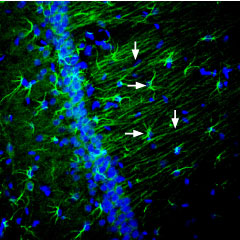Overview
- Peptide (C)RVIAQPENHAEAQE, corresponding to amino acid residues 148-161 of mouse Nectin-2 (Accession P32507). Extracellular, N-terminus.

 Western blot analysis of rat spleen lysate (lanes 1 and 4), human Jurkat T cell leukemia cell lysate (lanes 2 and 5) and human K562 erythroleukemia cell lysate (lanes 3 and 6):1-3. Anti-Nectin-2/PVRL2 (extracellular) Antibody (#ANR-052), (1:200).
Western blot analysis of rat spleen lysate (lanes 1 and 4), human Jurkat T cell leukemia cell lysate (lanes 2 and 5) and human K562 erythroleukemia cell lysate (lanes 3 and 6):1-3. Anti-Nectin-2/PVRL2 (extracellular) Antibody (#ANR-052), (1:200).
4-6. Anti-Nectin-2/PVRL2 (extracellular) Antibody, preincubated with Nectin-2/PVRL2 (extracellular) Blocking Peptide (#BLP-NR052).
 Expression of Nectin-2 in rat hippocampusImmunohistochemical staining of perfusion-fixed frozen rat brain sections using Anti-Nectin-2/PVRL2 (extracellular) Antibody (#ANR-052), (1:600), followed by goat-anti-rabbit-AleaxaFluor-488. Nectin-2 staining (green) appears in in apical dendrites of CA1 pyramidal neurons (vertical arrows) and in astrocytes (horizontal arrows). Cell nuclei are stained with DAPI (blue).
Expression of Nectin-2 in rat hippocampusImmunohistochemical staining of perfusion-fixed frozen rat brain sections using Anti-Nectin-2/PVRL2 (extracellular) Antibody (#ANR-052), (1:600), followed by goat-anti-rabbit-AleaxaFluor-488. Nectin-2 staining (green) appears in in apical dendrites of CA1 pyramidal neurons (vertical arrows) and in astrocytes (horizontal arrows). Cell nuclei are stained with DAPI (blue).
- Ogita, H. et al. (2010) Proc. Jpn. Acad. Ser. B Phys. Biol. Sci. 86, 621.
- Lopez, M. et al. (1998) Blood 92, 4602.
- Rikitake, Y. et al. (2012) J. Cell Sci. 125, 3713.
The Nectin family is known as cell-cell adhesion molecules and comprises four members in this family: nectin-1, nectin-2, nectin-3 and nectin-4 which are encoded by PVRL1, PVRL2, PVRL3, and PVRL4 genes respectively1. They are Ca2+-independent immunoglobulin-like CAMs and are able to trans-interact1.They are localized at adherens junctions between two neighboring cells and binds to afadin through their C-terminal region1.
Nectins, apart from a secreted nectin-1γ, exhibit three immunoglobulin-like loops (one V type and two C2 type) in their extracellular region, a single trans membrane segment and a cytoplasmic tail. Nectins first form a cis-homo-dimer which later on undergoes lateral cluster formation on the cell surface1. Nectins regulate a variety of cellular functions in addition to cell-cell junction formation such as cell polarity, movement, proliferation, differentiation, and survival1.
The PVRL2 gene (which encodes nectin-2) encodes two mRNA isoforms of 3 kb and 4.4 kb both widely expressed in various human tissues including hematopoietic cells of the myelo-monocytic and megakaryocytic lineages and detected also on the surface of endothelial cells2.
Nectin-2 acts as mediator of herpes simplex virus invasion into host cell. A single nucleotide polymorphism in PVRL2 shows an association with later onset of Alzheimers Disease3.
Application key:
Species reactivity key:
Alomone Labs is pleased to offer a highly specific antibody directed against an epitope of mouse Poliovirus receptor-related protein 2. Anti-Nectin-2/PVRL2 (extracellular) Antibody (#ANR-052) can be used in western blot, immunohistochemistry, and flow cytometry applications. It has been designed to recognize Nectin-2 from mouse, rat and human samples.

